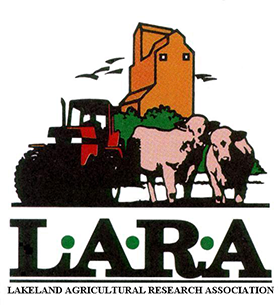Regional Annual Forage Variety Trials
The Annual Forage Trials (AFTs) began at LARA in 2008 with the purpose of comparing annual silage crops for whole-plant production when considering both yield and quality. Funding was obtained from the Alberta Beef Producers and the Ag and Food Council. The trial was seeded in four blocks of plots (barley, oats, triticale and alternatives) in three locations (Fort Kent, St. Paul and Lac La Biche).
This trial was expanded in 2009 to form the Regional Silage Trials, a provincial partnership between six applied research and forage associations with 11 plot sites across the province. The Alberta Beef Producers provided funding for this initiative and Alberta Agriculture has helped with seed coordination. While many of the associations involved have been growing silage trials for a number of years, this is the first coordinated effort to standardize protocol, variety selection and data reporting. Provincial protocol was established for five blocks of plots: barley, oats, triticale, pulses and late-seeded.
In partnership with the Association of Alberta Co-op Seed Cleaning Plants and the Alberta Seed Growers Association the Regional Silage Trial information will appear in the annual Spring Alberta’s Seed Guide (seed.ab.ca).
Participating Organizations
- Battle River Research Group
- Chinook Applied Research Association
- Gateway Research Organization
- North Peace Applied Research Association
- Peace Country Beef and Forage Association
- Smoky Applied Research and Demonstration Association
- West Central Forage Association
Cereals
An important aspect of crop production is variety selection and, with new varieties continually becoming available, current and comprehensive forage variety yield and quality data is essential to producers. Previous experience with cereal grain production and the Regional Variety Trials has shown that there can be a 15% increase in production from selecting the best varieties, which, on average, can be an increase of $25/acre.
Through the use of experience, neighbors and publications such as the Alberta Seed Guide (seed.ab.ca), we make variety selection decisions to benefit producers. However, there has been a lack of whole-plant annual forage production information to aid us in making cropping decisions for forage production.
The purpose of this trial is to supply producers with current and comprehensive annual forage variety yield and quality data for silage, greenfeed or swath grazing in Northeastern Alberta (crop zones 3 and 5) and across the province.
These trials have been grown for the past 10 years in the Lakeland in Lac La Biche County, County of St. Paul and the MD of Bonnyville. A summary is now available for Barley, Oats and Triticale here!
Pulses
The most commonly utilized forage crops are typically monocultures of barley, oats or triticale. Despite this, there are other annuals available that could provide an alternative crop for forage production or to extend the grazing season. The use of corn has significantly increased in recent years as a method of extending the grazing season. The use of alternative annual crops can provide a break in disease from cereal production or as a break in perennial cropping rotation while still providing a forage crop.
The inclusion of peas into the production of an annual cereal crop can provide multiple benefits over the use of a monoculture cereal. Fertilizer costs could be reduced due to the ability of peas to fix nitrogen, which could also impact overall soil fertility. Peas have a high protein content and will therefore add protein to the overall forage quality.
To view the 2016 Cereal results, Click Here.
To view the 2016 Pulse results, Click Here.
To view the 2017 Cereal results, Click Here.
To view the 2017 Pulse results, Click Here.
To read more about Annual Forages, click here.

